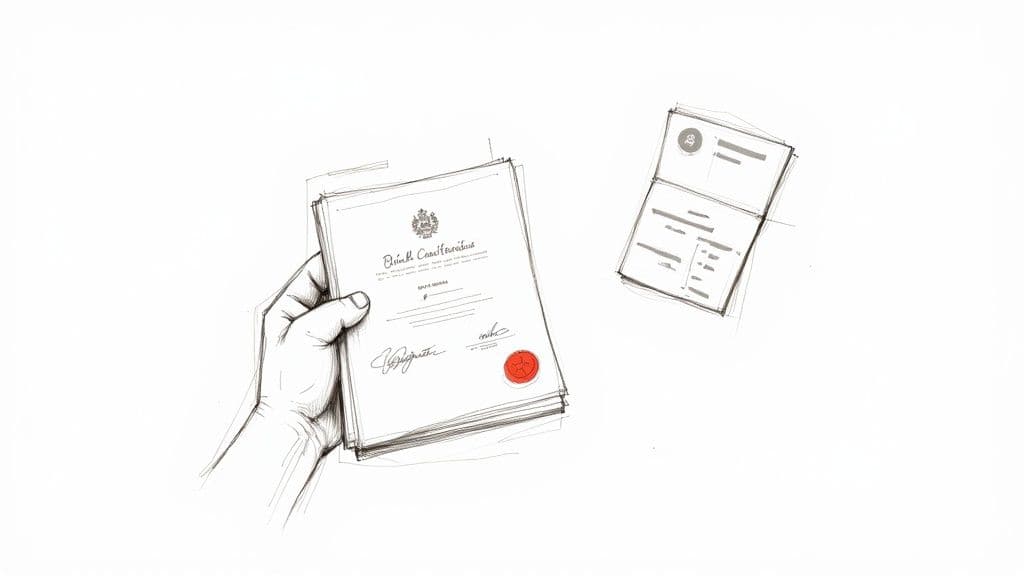When you apply for a U.S. passport, the one document you absolutely can't skip is a certified copy of your birth certificate. I'm not talking about a quick photocopy from your home printer or that pretty, commemorative certificate the hospital gave your parents. Those won't work.
Submitting the wrong type of birth certificate is one of the most common mistakes people make, and it’s a surefire way to get your passport application delayed or even flat-out rejected. Getting this right from the start saves a ton of headaches down the road.
Why Certified is the Only Way to Go
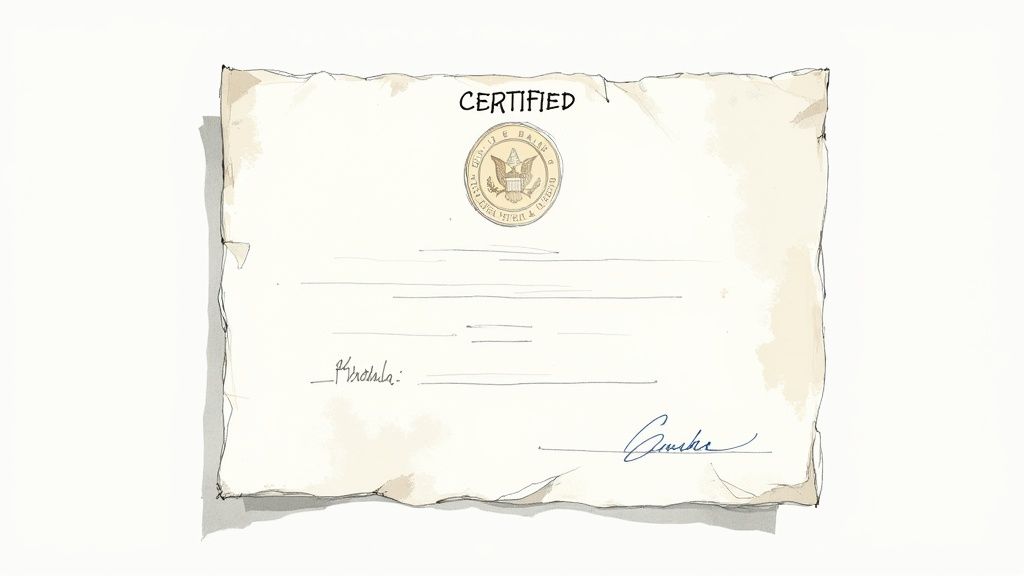
Think of it from the U.S. Department of State's perspective. Their job is to confirm, without a shadow of a doubt, that you are who you say you are and that you're a U.S. citizen. A simple photocopy is too easy to fake or alter, and a hospital souvenir certificate has no legal weight.
Only an official, certified copy issued by a government vital records office has the security features needed to meet strict federal standards. This isn't just a U.S. quirk; it's a global standard. Across the world, a certified birth certificate is the bedrock document for proving identity and citizenship, a point underscored by organizations like UNICEF, which highlights the global importance of birth registration.
What Does "Certified" Actually Mean?
So, what separates a real certified copy from any other version? It's all about the built-in security features that prove its authenticity. A legitimate certified birth certificate will always have these three things:
- A Raised or Embossed Seal: You can literally feel this. Run your thumb over the seal from the issuing office—it should be raised off the paper, a feature that’s incredibly difficult to forge.
- An Official's Signature: Look for the signature of a registrar from the city, county, or state vital records office.
- Special Security Paper: These documents are printed on unique paper, often with watermarks or other anti-fraud features woven right in.
Key Takeaway: If the document you have is missing any of these features, the passport agency will reject it. They need absolute certainty that the information is accurate and hasn't been tampered with, as your birth certificate is the cornerstone of your citizenship claim.
Making sure you have this specific, official document in hand is truly the first step. Before you waste time filling out forms or getting photos taken, confirm you have the right kind of birth certificate.
Finding the Right Vital Records Office
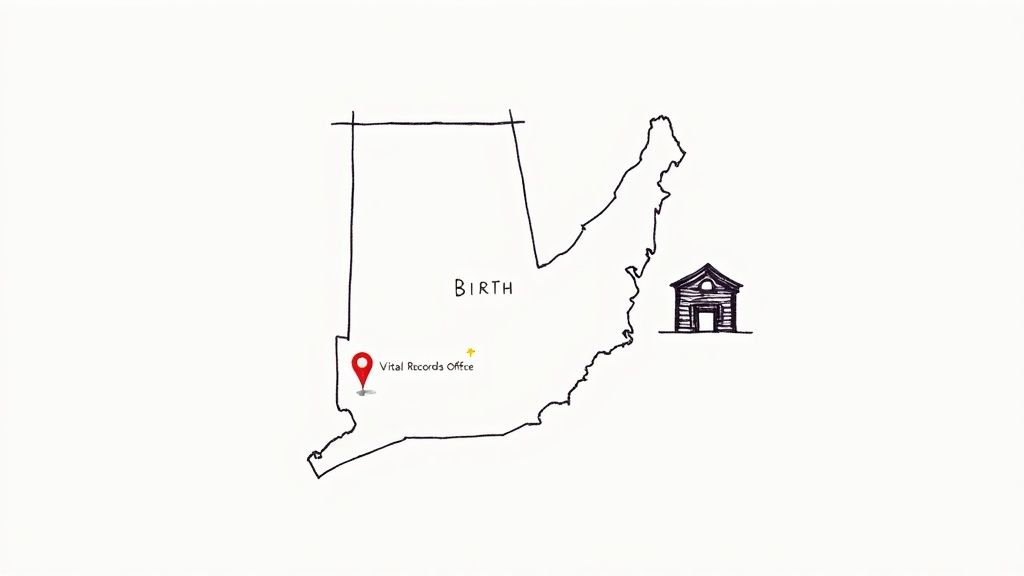
Before you can even think about ordering a certified copy of your birth certificate, you need to know exactly who to ask. This is the first and most common hurdle people face, and it’s a simple one: you must contact the vital records office in the state and county where you were born, not where you currently live.
It seems obvious, but you'd be surprised how often it happens. If you were born in Dallas but moved to Denver twenty years ago, the Colorado records office can’t help you. You have to go straight to the source in Texas.
Pinpointing the Correct Agency
Here's where it gets a little tricky. There’s no single name for the office that handles these documents. Depending on the state, you might be looking for a "Department of Health," a "Bureau of Vital Statistics," or even the "County Clerk-Recorder." The terminology is all over the map.
To cut through the confusion and find the right place, here’s what I always recommend:
- Start with a state-level search: Head to your search engine and type in something like
[Your Birth State] vital recordsor[Your Birth State] department of health. This usually points you to the main state agency. - Drill down to the county: For a more direct hit, try searching for
[Your Birth County] clerk recorderor[Your Birth County] vital records.
For example, a quick search for "Cook County vital records" will take you directly to the correct office for anyone born in Chicago. This targeted approach helps you sidestep the noise and land on the official government page.
A Word of Caution: Watch out for third-party services that often dominate search results. While a few are legitimate partners, many are just middlemen that charge you extra fees to do the exact same paperwork you can do yourself. Always look for the official government website—it will usually have a .gov domain—to avoid markups and delays.
Getting this first step right is everything. It ensures you’re working with the official source, which is the only way to get the certified document the U.S. Passport Agency will accept. Start with your place of birth, find the official office, and you’ll save yourself a ton of time and frustration.
How to Request Your Birth Certificate
Once you've pinpointed the right vital records office, you need to decide how to actually ask for the document. You've got three main ways to go: ordering it online, showing up in person, or sending an application through the mail. Each route has its pros and cons, boiling down to how quickly you need it, your budget, and what works best for you.
Choosing the right path from the get-go is the key to getting that certified copy for your passport without any extra headaches.
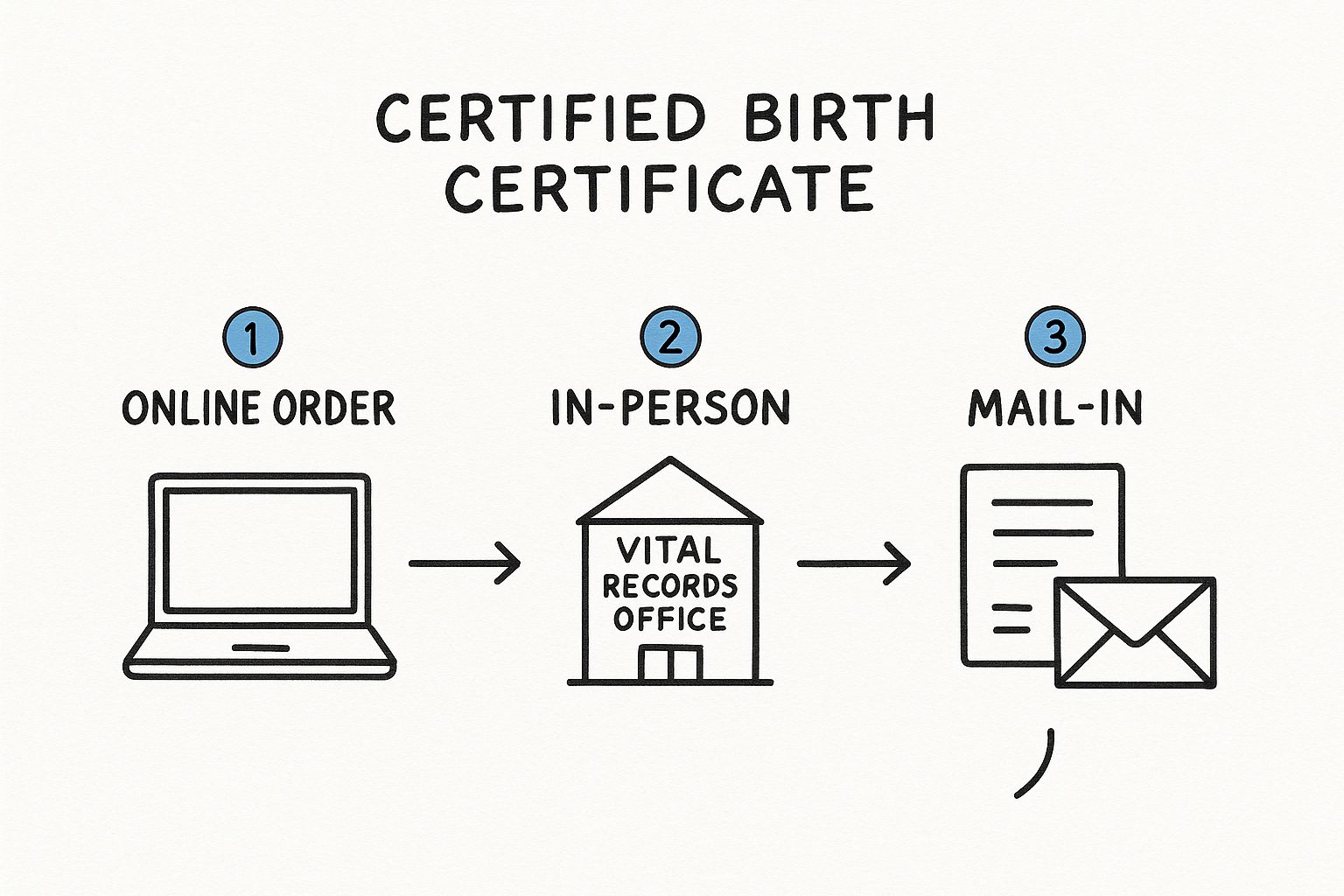
As you can see, the method you pick directly affects how long it takes and what you'll have to do to get that document in your hands.
Ordering Your Certificate Online
For most people, ordering online is the path of least resistance. You can either use your state's official vital records website or go through a trusted third-party service like VitalChek. While state websites are the most direct option, let's be honest—some of them can be a pain to navigate.
Reputable third-party services often provide a much smoother experience and better customer support, but they do charge an extra service fee for the convenience.
The process itself is usually pretty simple:
- You’ll fill out an online application with your personal information.
- Next, you'll upload a clear copy of a government-issued photo ID, like your driver's license.
- Finally, you pay the fees with a credit or debit card.
This is the perfect choice if you're looking for speed and simplicity, especially if you don't live anywhere near the office that holds your records.
Visiting the Office in Person
Live close to the vital records office in your birth state or county? Need that certificate, like, yesterday? An in-person visit is your best bet, hands down.
In many places, you can walk out with your certified birth certificate the very same day. That kind of speed is a massive advantage if you're up against a tight deadline for a passport application. Just be sure to show up prepared. You'll absolutely need your valid, unexpired photo ID and a way to pay. It’s a good idea to check their website beforehand for their walk-in hours and what payment methods they accept—some smaller offices might not take credit cards.
Why the big deal about a certified copy? This isn't just a U.S. thing; it's a standard international practice. The government relies on it as the primary proof of citizenship to prevent fraud and protect national security. These policies became much stricter after events like 9/11. To get a better sense of the data behind these identity rules, you can explore U.S. passport statistics and reports on travel.state.gov.
Applying for Your Certificate by Mail
If you're not in a hurry and want to save a few bucks, applying by mail is often the most budget-friendly option. It's also the slowest.
You'll need to find and download the official application form from the vital records website, fill it out completely, and possibly get your signature notarized—this varies by state. Then you mail the form, a photocopy of your ID, and a check or money order. My advice? Triple-check everything before sealing that envelope. A simple mistake, like sending the wrong fee amount, can get your request bounced right back to you, forcing you to start the whole process over.
Comparing Birth Certificate Request Methods
With three different ways to get your document, it helps to see them side-by-side to figure out which one fits your situation.
| Method | Typical Processing Time | Average Cost Range | Best For |
|---|---|---|---|
| Online | 1-3 weeks (plus shipping) | $30 - $60 | Convenience and for people living out of state. |
| In-Person | Same day to a few hours | $15 - $35 | Speed and last-minute needs when you're local. |
| 4-8 weeks or longer | $15 - $30 | Saving money when you have plenty of time. |
Ultimately, the best method really depends on your timeline and budget. If you're in a rush, a trip to the office is worth the effort. If you have a few weeks to spare, ordering online or by mail can work just fine.
Understanding the Costs, Timelines, and How to Speed Things Up
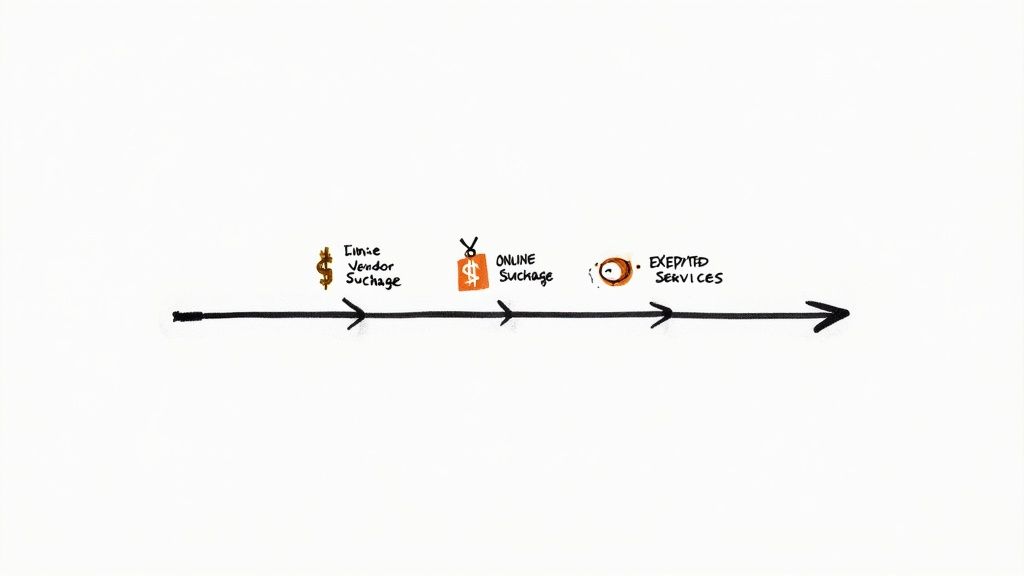
When you're getting ready to apply for a passport, two of the biggest questions on your mind are probably "How much will this cost?" and "How long will this take?" The truth is, there isn't one simple answer for getting a certified copy of your birth certificate. The final price tag is a mix of the state's fee, charges from any service you use, and shipping costs.
The base fee for the certificate itself usually falls somewhere between $15 to $35, but this can vary quite a bit depending on where you were born. If you opt for the convenience of ordering online through a third-party service, you’ll likely see an additional service fee tacked on, typically in the $15 to $25 range. This extra cost covers their simplified ordering platform and any customer support they provide.
How Long Will I Be Waiting?
This is where things can get tricky. Processing times are all over the map. If you're lucky enough to live near the vital records office, you might be able to go in person and walk out with your document the very same day. That’s the dream scenario.
For most people ordering by mail or online, the wait is significantly longer. You could be looking at anywhere from two to eight weeks, and in some bigger cities or during peak season, it can stretch out even further. You have to factor this wait time into your passport application plan.
If your trip is just around the corner, paying extra to expedite your request is almost always worth it. It’s a bit more money upfront, but it can save you a world of stress.
Here’s what that usually looks like:
- Expedited Processing: Many states and online vendors offer to push your request to the front of the line for an extra fee, often getting it done in just a few business days.
- Overnight Shipping: You can also spring for express shipping to cut down on the time it takes for the document to get to your mailbox.
Opting to expedite your birth certificate request can add another $20 to $50 (or more) to your total. But when you’re on a tight deadline, that peace of mind is priceless. Remember, the birth certificate is just one piece of the puzzle; you can get a better handle on the full cost of a passport to plan your budget. Ultimately, whether you need to expedite comes down to how soon you plan to travel.
Common Mistakes That Delay Your Passport
Getting a certified copy of a birth certificate for a passport should be simple, but I've seen countless people get tripped up by a few preventable errors that cause serious delays. The most common mistake? Ordering the wrong document.
It’s easy to accidentally request a "short-form" or "abstract" version of your birth certificate. These are often just commemorative or informational copies, and the U.S. Department of State will reject them flat out.
What you absolutely need is the "long-form" or "vault" copy. This is the official, detailed record that includes everything the passport agency needs to see—your parents' full names, the city you were born in, and even the name of the attending physician. When you're filling out the request, always look for the option explicitly labeled for passport or identification purposes.
Another classic snag is messing up the payment or identification. Sending a personal check when the office only accepts money orders, or getting the fee wrong by just a few dollars, will get your application sent right back to you. The same goes for your ID—if you forget to include a clear copy of your driver's license or other valid photo ID, your request is dead on arrival.
Pro Tip: Before you mail anything or click submit online, do a quick final review. Is it the long-form copy? Is the payment amount exact and in the right format? Is your ID copy legible? A 30-second check can easily save you weeks of frustrating delays.
Other Costly Oversights
Beyond those big three, a few smaller details can also derail your application. You'd be surprised how many requests are rejected simply because of sloppy handwriting or a missed field on the form. If a clerk can't decipher your address, you’re not getting that certificate.
Here’s how to sidestep these issues:
- Type it out. If there’s a fillable PDF form available, use it. Your information will be perfectly clear.
- Proofread everything. Double-check that every name is spelled correctly and every date is accurate. One wrong digit can cause a mismatch.
- Confirm the address. Government office locations can change. A quick search to verify you have the current mailing address for the vital records office is always a good idea.
Having the right documents is the foundation of any successful application. If you're managing other official processes, a solid checklist is your best friend, much like the one we've outlined in our B-2 visa documents checklist.
Your Questions Answered
Even when you know the steps, real life throws curveballs. Let's walk through some of the most common questions and tricky situations that pop up when you're trying to get a certified birth certificate for a passport application.
What If My Name Changed?
This is a huge one, and it trips a lot of people up. If your current legal name doesn't match the name on your birth certificate—maybe due to marriage, divorce, or a court order—you can't just send in the certificate as-is. The government needs to see the paper trail.
You'll have to submit an original or certified copy of the legal document that shows the name change. This could be:
- A marriage certificate
- A divorce decree
- A court-ordered name change document
Think of it as connecting the dots for the passport agency. Submitting this along with your application creates a clear, legal link between your birth name and your current name.
Can I Order for a Newborn or a Deceased Family Member?
You absolutely can, but the process has a few extra wrinkles.
For a newborn, you'll need to wait until the birth is officially registered with the state, which can take a few weeks. Once it's in the system, you can order it just like any other.
Ordering for a deceased family member is more restricted. Typically, you must be an immediate relative—a spouse, parent, or child—and you'll likely need to provide proof of your relationship and a copy of the death certificate.
Crucial Reminder: A digital copy is a non-starter. The passport agency will only accept the physical, certified paper document with a raised or embossed seal. A photo on your phone or a PDF will get your application kicked back immediately, creating a major delay.
This requirement for original documents is common in legal processes. For instance, when sponsoring a relative, knowing the rules for an affidavit of support for a tourist visa helps you avoid the same kind of documentation mistakes.
Navigating U.S. visa appointments can be a waiting game. With Vast Fisa, you can skip the long lines by receiving instant alerts or letting us automatically reschedule your appointment for the earliest possible date. Find out how you can secure your appointment sooner at https://www.vastfisa.com.
